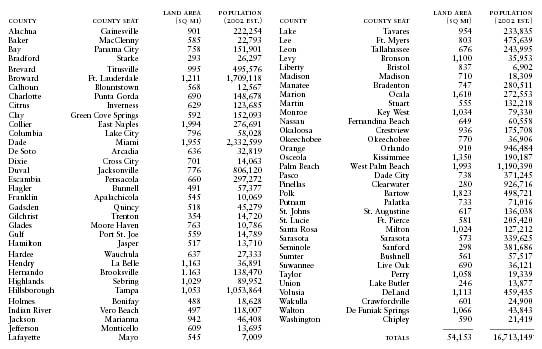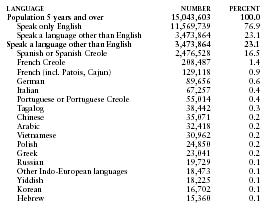Florida
Languages
Spanish and English settlers found what is now Florida inhabited by Indians recently separated from the Muskogean Creeks, who, with the addition of escaped black slaves and remnants of the Apalachee Indians of the panhandle, later became known as the Seminole Indians. Although the bulk of the Seminole were removed to Indian Territory in the 1840s, enough remained to provide the basis of the present population. Florida has such Indian place-names as Okeechobee, Apalachicola, Kissimmee, Sarasota, Pensacola, and Hialeah.
The rapid population change that has occurred in Florida since World War II makes accurate statements about the language difficult. Massive migration from the North Central and North Atlantic areas, including a large number of speakers of Yiddish, has materially affected the previously rather uniform Southern speech of much of the state. Borrowing from the Spanish of the expanding number of Cubans and Puerto Ricans in the Miami area has had a further effect.
Representative words in the Southern speech of most native-born Floridians are light bread (white bread), pallet (temporary bed on the floor), fairing off (clearing up), serenade (shivaree),

Florida Counties, County Seats, and County Areas and Populations
| COUNTY | COUNTY SEAT | LAND AREA (SQ MI) | POPULATION (2002 EST.) | COUNTY | COUNTY SEAT | LAND AREA (SQ MI) | POPULATION (2002 EST.) |
| Alachua | Gainesville | 901 | 222,254 | Lake | Tavares | 954 | 233,835 |
| Baker | MacClenny | 585 | 22,793 | Lee | Ft. Myers | 803 | 475,639 |
| Bay | Panama City | 758 | 151,901 | Leon | Tallahassee | 676 | 243,995 |
| Bradford | Starke | 293 | 26,297 | Levy | Bronson | 1,100 | 35,953 |
| Brevard | Titusville | 995 | 495,576 | Liberty | Bristol | 837 | 6,902 |
| Broward | Ft. Lauderdale | 1,211 | 1,709,118 | Madison | Madison | 710 | 18,309 |
| Calhoun | Blountstown | 568 | 12,567 | Manatee | Bradenton | 747 | 280,511 |
| Charlotte | Punta Gorda | 690 | 148,678 | Marion | Ocala | 1,610 | 272,553 |
| Citrus | Inverness | 629 | 123,685 | Martin | Stuart | 555 | 132,218 |
| Clay | Green Cove Springs | 592 | 152,093 | Monroe | Key West | 1,034 | 79,330 |
| Collier | East Naples | 1,994 | 276,691 | Nassau | Fernandina Beach | 649 | 60,558 |
| Columbia | Lake City | 796 | 58,028 | Okaloosa | Crestview | 936 | 175,708 |
| Dade | Miami | 1,955 | 2,332,599 | Okeechobee | Okeechobee | 770 | 36,906 |
| De Soto | Arcadia | 636 | 32,819 | Orange | Orlando | 910 | 946,484 |
| Dixie | Cross City | 701 | 14,063 | Osceola | Kissimmee | 1,350 | 190,187 |
| Duval | Jacksonville | 776 | 806,120 | Palm Beach | West Palm Beach | 1,993 | 1,190,390 |
| Escambia | Pensacola | 660 | 297,272 | Pasco | Dade City | 738 | 371,245 |
| Flagler | Bunnell | 491 | 57,377 | Pinellas | Clearwater | 738 | 371,245 |
| Franklin | Apalachicola | 545 | 10,069 | Polk | Bartow | 1,823 | 498,721 |
| Gadsden | Quincy | 518 | 45,279 | Putnam | Palatka | 733 | 71,016 |
| Gilchrist | Trenton | 354 | 14,720 | St. Johns | St. Augustine | 617 | 136,038 |
| Glades | Moore Haven | 763 | 10,786 | St. Lucie | Ft. Pierce | 581 | 205,420 |
| Gulf | Port St. Joe | 559 | 14,789 | Santa Rosa | Milton | 1,024 | 127,212 |
| Hamilton | Jasper | 517 | 13,710 | Sarasota | Sarasota | 573 | 339,625 |
| Hardee | Wauchula | 637 | 27,333 | Seminole | Sanford | 298 | 381,686 |
| Hendry | La Belle | 1,163 | 36,891 | Sumter | Bushnell | 561 | 57,517 |
| Hernando | Brooksville | 1.163 | 138,470 | Suwannee | Live Oak | 690 | 36,121 |
| Highlands | Sebring | 1,029 | 89,952 | Taylor | Perry | 1,058 | 19,339 |
| Hillsborough | Tampa | 1,053 | 1,053,864 | Union | Lake Butler | 246 | 13,877 |
| Holmes | Bonifay | 488 | 18,628 | Volusia | DeLand | 1,113 | 459,435 |
| Indian River | Vero Beach | 497 | 118,007 | Wakulla | Crawfordville | 601 | 24,900 |
| Jackson | Marianna | 942 | 46,408 | Walton | De Funiak Springs | 1,066 | 43,843 |
| Jefferson | Monticello | 609 | 13,695 | Washington | Chipley | 590 | 21,419 |
| Lafayette | Mayo | 545 | 7,009 | —————— | —————— | ||
| TOTALS | 54,153 | 16,713,149 |
tote (carry), snap beans (green beans); mosquito hawk (dragonfly), crocus sack (burlap bag), pullybone (wishbone), and comforter (tied and filled bedcover), especially in south Florida. Largely limited to the northern half of the state are pinder (peanut), croker sack instead of crocus sack, fire dogs (andirons); also, in the Tampa Bay area, comfort (tied and filled bedcover), and, in the panhandle, whirlygig (merry-go-round). Some north-Florida terms are clearly imported from Georgia: mutton corn (green corn), light-wood (kindling), and co-wench! (a call to cows).
In 2000, 11,569,739 Floridians—76.9% of the resident population five years old and older—spoke only English at home, down from 82.7% in 1990.
The following table gives selected statistics from the 2000 census for language spoken at home by persons five years old and over. The category "Other Indo-European languages" includes Albanian, Gaelic, Lithuanian, and Rumanian.

| LANGUAGE | NUMBER | PERCENT |
| Population 5 years and over | 15,043,603 | 100.0 |
| Speak only English | 11,569,739 | 76.9 |
| Speak a language other than English | 3,473,864 | 23.1 |
| Speak a language other than English | 3,473,864 | 23.1 |
| Spanish or Spanish Creole | 2,476,528 | 16.5 |
| French Creole | 208,487 | 1.4 |
| French (incl. Patois, Cajun) | 129,118 | 0.9 |
| German | 89,656 | 0.6 |
| Italian | 67,257 | 0.4 |
| Portuguese or Portuguese Creole | 55,014 | 0.4 |
| Tagalog | 38,442 | 0.3 |
| Chinese | 35,071 | 0.2 |
| Arabic | 32,418 | 0.2 |
| Vietnamese | 30,962 | 0.2 |
| Polish | 24,850 | 0.2 |
| Greek | 23,041 | 0.2 |
| Russian | 19,729 | 0.1 |
| Other Indo-European languages | 18,473 | 0.1 |
| Yiddish | 18,225 | 0.1 |
| Korean | 16,702 | 0.1 |
| Hebrew | 15,360 | 0.1 |